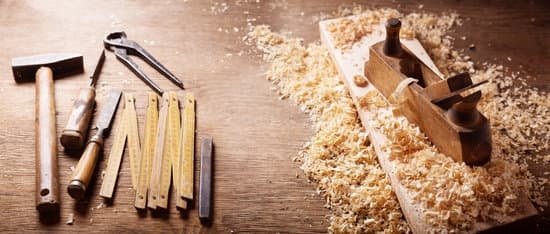Woodworking projects often require the use of dowels, small cylindrical rods that play a crucial role in providing strength and stability to joints. Understanding the quantity of dowels needed is essential for ensuring the success of any woodworking endeavor. In this blog post, we will delve into the importance of dowels in woodworking and explore various techniques and tools used to accurately determine the number of dowels required for different projects.
Dowels are a vital component in woodworking as they provide added reinforcement to joints, enhancing the overall structural integrity of furniture, cabinets, bookshelves, and other wooden creations. Without dowels, joints may become weak over time or fail altogether. Hence, having a solid understanding of how many dowels are required for a specific project is crucial.
Determining the number of dowels needed involves considering several factors such as wood material density, weight-bearing capacity of the project, dimensions of wood pieces being joined, type of joint being created, as well as stress and load factors. By carefully evaluating these elements and accurately calculating dowel quantities, woodworkers can ensure projects that are durable and built to last.
In the following sections of this blog post, we will discuss different types of dowels available in the market and their pros and cons. We will also highlight traditional formulas and techniques used to calculate dowel quantities based on joint types and wood thickness.
Additionally, we will explore advanced approaches using modern tools such as computer-aided design (CAD) software and smartphone applications for precise calculations. Finally, we will provide practical tips for sourcing dowels efficiently and offer troubleshooting advice for common mistakes encountered during woodworking projects.
By familiarizing ourselves with these essential aspects of determining dowel quantities in woodworking, we can elevate our craftsmanship and ensure sturdy construction that withstands the test of time. So let’s dive in.
What Are Dowels and Their Various Types in Woodworking
Dowels are an essential component in woodworking projects, serving a variety of functions. They are cylindrical rods typically made of wood, metal, or plastic that are used to reinforce joints and provide additional strength and stability to assembled pieces. In this section, we will explore what dowels are and discuss the various types available in the market.
In woodworking, dowels are primarily used to create strong, durable joints between two or more pieces of wood. They act as a reinforcement by distributing stress evenly across the joint and preventing movement or separation. Dowels also help align and secure parts during assembly, ensuring precise and accurate connections.
There are several types of dowels to choose from when working on woodworking projects. The most common types include wooden dowels, metal dowels (such as steel or aluminum), and plastic dowels. Each type has its own set of advantages and disadvantages.
Wooden dowels are popular for their natural look and blend well with wooden furniture and structures. They can be easily shaped and sanded to match the contours of the project. However, wooden dowels may not be suitable for heavy-duty projects due to their tendency to break under excessive pressure.
Metal dowels offer exceptional strength and stability, making them ideal for load-bearing applications or projects that require superior durability. These dowels are resistant to bending or warping even under significant weight or stress. However, they may not be as visually appealing as wooden dowels due to their metallic finish.
Plastic dowels provide a lightweight alternative with good resistance to corrosion and moisture. They are less likely to damage surrounding materials during installation compared to metal or wooden dowels. Plastic dowels may not be as strong as metal ones but still serve well in non-load-bearing applications or where weight is a concern.
Understanding the different types of dowels available enables woodworkers to make informed decisions when selecting the appropriate type for their specific projects. Each type has its own strengths and weaknesses, so it’s essential to consider the project requirements, desired aesthetics, and expected load-bearing capacity before making a choice.
Factors to Consider When Determining the Number of Dowels Required
When embarking on a woodworking project, it is crucial to accurately determine the number of dowels required. This ensures that the joint is strong and sturdy, preventing any potential structural issues in the future. Several factors need to be considered when determining the quantity of dowels needed for a woodworking project.
1. Wood Material and Density:
The type of wood being used plays a significant role in determining the number of dowels required. Different wood species have varying densities, which can affect their load-bearing capacity. Hardwoods generally require more dowels compared to softwoods due to their higher density. It is essential to consider the characteristics of the wood being used and select an appropriate quantity of dowels accordingly.
2. Weight-Bearing Capacity:
The weight-bearing capacity of the project is another crucial factor in determining the number of dowels needed. If the woodworking project will bear heavy loads, such as shelves or furniture, it requires additional support from dowels. The weight that will be placed on the joint must be taken into account when calculating dowel quantities.
3. Length and Width of Wood Pieces Being Joined:
The size and dimensions of the wood pieces being joined also impact the number of dowels required. Longer or wider pieces generally necessitate more dowels for stability and strength. The spacing between each dowel is also important, as too little spacing may weaken the joint while excessive spacing may result in inadequate support.
4. Type of Joint Being Created:
Different types of joints require different numbers and arrangements of dowels for optimal strength. For example, a butt joint would typically require fewer dowels compared to a mortise and tenon joint. Understanding the specific joint being utilized in your woodworking project will guide you towards an appropriate quantity of dowels.
5. Stress and Load Factors:
Consideration should be given to any additional stress or load factors that may affect your woodworking project over time. For instance, if a chair will be subjected to repeated weight and movement, more dowels may be required to reinforce the joint. Anticipating these factors and incorporating them into your calculations will ensure a durable and long-lasting end product.
By taking all these factors into account, you can accurately determine the number of dowels required for your woodworking project. Failure to consider these variables may result in weak joints or structural issues. Spending time upfront to carefully calculate dowel quantities will ultimately lead to a more successful and reliable woodworking endeavor.
Calculating Dowel Quantity
When it comes to woodworking projects that involve joining pieces of wood together, accurate calculations for the number of dowels required are essential. This section will explain the traditional formulas and techniques used to determine dowel quantity, ensuring that your projects are sturdy and well-joined.
Traditionally, woodworkers have relied on specific formulas based on joint types and wood thickness to estimate the number of dowels needed. Here are some commonly used methods:
- Rule of thumb: One dowel per inch: This basic rule suggests using one dowel for every inch of thickness in the wood being joined. For example, if you are joining two ¾-inch thick boards, you would typically use two dowels.
- The Krenov Method: Developed by renowned furniture maker James Krenov, this method involves calculating the circumference of each dowel and dividing it by the spacing between the centerline of each dowel. The result is then multiplied by the total length of the joint to determine the number of dowels needed.
| Formula | Description |
|---|---|
| Rule of thumb: One dowel per inch | Used for basic calculations where one dowel is recommended for every inch in thickness. |
| The Krenov Method | Based on calculating circumference and spacing between dowels to determine a more precise estimate. |
It’s worth noting that these traditional formulas provide rough estimates and may not account for factors such as stress, load capacity, or end grain orientation. However, they can serve as a starting point when determining the initial number of dowels needed for a project.
In addition to these formulas, precise measurement and marking techniques are crucial for accurate calculations. Taking into account the length and width of the wood pieces being joined, as well as the type of joint being created, will help ensure proper alignment of dowel holes.
By following these traditional methods and techniques, woodworkers can confidently estimate the quantity of dowels required for their projects, contributing to the overall strength and durability of their woodworking creations. In the next section, we will explore advanced approaches that utilize modern tools and software for even more precise calculations.
Advanced Approaches to Accurately Determine Dowel Quantity
In addition to traditional formulas and techniques, there are advanced approaches that can be used to accurately determine the quantity of dowels needed for woodworking projects. These modern techniques and tools can greatly simplify the estimation process and ensure precise calculations.
One such approach is the use of computer-aided design (CAD) software. CAD software allows woodworkers to create detailed 3D models of their projects and simulate various joints and connections. With this software, it becomes possible to input specific dimensions, wood types, and joint types to determine the exact number of dowels required.
CAD software takes into account factors such as wood density, weight-bearing capacity, stress, and load distribution, resulting in highly accurate calculations. This approach is particularly beneficial for complex projects with multiple joints and varying thicknesses of wood.
Another advanced approach is the use of digital tools and smartphone applications designed specifically for woodworking calculations. These tools leverage the power of technology to provide quick and accurate estimates of dowel quantities.
Some apps allow users to input project details such as wood type, joint type, and dimensions, and then generate a comprehensive report detailing the number of dowels needed for each specific joint. These digital tools often come equipped with additional features like material wastage calculation, contingency planning, and even recommendations for drilling hole positions.
By using these advanced approaches, woodworkers can save time and avoid potential wastage or errors in estimating dowel quantities. The precision provided by CAD software and digital tools ensures that projects are properly planned from the start, leading to stronger joints and more successful woodworking endeavors.
- Computer-aided design (CAD) software: This powerful tool allows woodworkers to create detailed 3D models of their projects. By inputting specific dimensions, wood types, joint types, CAD software can calculate the precise number of dowels required.
- Digital tools and smartphone applications: There are various apps available that are specifically designed for woodworking calculations. These tools allow users to input project details and generate comprehensive reports detailing the number of dowels needed for each joint.
Using these advanced approaches not only simplifies the estimation process but also ensures accuracy in determining dowel quantities. Woodworkers can benefit from avoiding potential wastage and errors, resulting in stronger joints and successful woodworking projects.
Practical Tips and Tricks for Efficient Usage of Dowels
Sourcing dowels: Where to buy and what to consider
When it comes to sourcing dowels for your woodworking projects, there are several options available. One of the most convenient ways is to purchase them from a local hardware store or home improvement center. These establishments typically carry a variety of dowel types and sizes, allowing you to choose the ones that best suit your project.
However, if you’re looking for specialized dowels or unique materials, you may need to explore other avenues. Online retailers and woodworking supply stores often offer a wider range of options, including exotic wood species or custom-sized dowels. Additionally, some craft stores may have smaller diameter dowels suitable for intricate work or fine detail.
Before purchasing your dowels, consider factors such as material quality and consistency. Look for straight and defect-free dowels that are free from cracks or knots. If possible, examine the grains to ensure they align with your aesthetic preferences.
Proper measuring techniques for accurate calculations
Accurate measurements are crucial when calculating the number of dowels required for your project. To determine the ideal length of each dowel, measure the depth of both pieces being joined along with any additional space required for tenons or mortises.
Additionally, it’s important to properly measure the diameter of the holes where the dowels will be inserted. Use calipers or a drill bit gauge set to determine the exact size needed. It’s common practice to select a drill bit that matches the diameter of the dowel itself.
Implementing precise measurements will contribute to strong joints and prevent any misalignments in your project.
Understanding wastage and contingency: Buying extra dowels
Woodworking projects can sometimes be unpredictable, resulting in accidental breakages or mistakes during assembly. It’s crucial to account for these potential setbacks by purchasing extra dowels as contingency stock.
As a general rule of thumb, it’s advisable to buy at least 10-20% more dowels than initially calculated. This additional quantity will provide you with ample spare pieces in case of any mishaps or when adjustments need to be made during construction.
Furthermore, having leftover dowels can be useful for future projects or repairs, saving you the hassle of having to source them again. Remember to store your extra dowels properly in a cool, dry place to maintain their integrity and prevent any warping or damage.
Taking into account potential wastage and including contingency stock will help ensure that you have sufficient dowels on hand throughout your woodworking project.
Real-Life Examples
In this section, we will showcase specific woodworking projects and their dowel quantity requirements. Each project will highlight the factors and calculations used in determining the number of dowels needed for a successful construction.
- Bookshelf The first real-life example is a bookshelf made of pine wood. The dimensions of the bookshelf are 5 feet in height, 3 feet in width, and 1 foot in depth. It will have three shelves with equal spacing between them. Based on these measurements, the following dowel quantity calculation can be made:
- Chair The second example is a wooden chair made from oak wood. This chair design includes four legs, a seat, and a backrest. The dimensions are as follows: seat height – 1 foot, seat width – 1 foot, backrest height – 2 feet.
- Cabinet The third example is a cabinet made of walnut wood. The dimensions of the cabinet include a height of 6 feet, a width of 4 feet, and a depth of 2 feet. This cabinet design includes two doors with three shelves inside.
– For the vertical joints (connecting shelves to the sides), four dowels will be required for each shelf. Therefore, a total of 12 dowels would be needed for all three shelves.
– For the horizontal joints (connecting shelves to each other), two dowels per joint would suffice. As there are two joints for each shelf, a total of six dowels is required.
Therefore, the total quantity of dowels needed for this bookshelf would be 18.
To determine the approximate number of dowels needed for this chair:
– For each leg-to-seat joint, two or three dowels should be sufficient depending on the weight-bearing capacity desired. Therefore, with four legs, a total of 8 to 12 dowels will be required.
– For attaching the backrest to the seat, two vertical joints and one horizontal joint should be considered. Each joint can utilize three or four dowels depending on reinforcement needs. So in total, around nine to twelve dowels would be necessary.
Considering these factors, the estimated dowel quantity for this chair will be around 17 to 24.
To calculate the dowel numbers needed for this cabinet:
– For each door, three hinges will be used, requiring three dowels per hinge. So for both doors combined, six dowels would be needed.
– Inside the cabinet, there will be six vertical joints connecting the shelves to the sides. Each joint can utilize two or three dowels, depending on the weight-bearing capacity desired. Therefore, a total of 12 to 18 dowels would be necessary for these joints.
Hence, the estimated dowel quantity for this cabinet would be around 18 to 24.
These real-life examples demonstrate how different woodworking projects require varied quantities of dowels depending on their dimensions and structural needs. By understanding these calculations and applying them accurately, woodworkers can ensure sturdy and well-joined constructions that stand the test of time.
| Woodworking Project | Dowel Quantity Required |
|---|---|
| Bookshelf (pine wood) | 18 |
| Chair (oak wood) | 17-24 |
| Cabinet (walnut wood) | 18-24 |
Common Mistakes and Troubleshooting Guide
Addressing common errors in dowel quantity estimations
When determining the quantity of dowels needed for a woodworking project, there are several common mistakes that beginners often make. One of the most common errors is underestimating the number of dowels required. This can lead to a project lacking structural integrity and durability. It is important to remember that dowels not only provide strength but also help with alignment and stability.
To avoid this mistake, it is essential to carefully follow the calculations and formulas provided in section 4. Take into account all the factors mentioned earlier, such as wood material density, weight-bearing capacity, length and width of wood pieces being joined, type of joint, and stress/load factors. By considering these factors accurately, you can ensure that you have enough dowels for a strong and sturdy structure.
Another common mistake is overestimating the number of dowels needed. While it may seem like having more dowels would increase the strength of your project, it can actually weaken it by creating unnecessary holes in the wood or causing splitting. Overdoweling can also be wasteful and increase costs unnecessarily.
Offering troubleshooting tips for projects with misaligned dowel holes
Misaligned dowel holes can be frustrating and affect the overall appearance and functionality of your woodworking project. There are a few troubleshooting tips that can help you overcome this issue.
Firstly, if you encounter misalignment while drilling your dowel holes, stop immediately to prevent any further damage. Proceeding with misaligned holes will compromise the accuracy and stability of your joinery. Instead, carefully measure again and mark new hole locations before proceeding with drilling.
If you have already drilled misaligned holes, don’t panic. One potential solution is to use larger diameter dowels or reinforced joints to fill the existing holes while still providing adequate strength. This requires careful planning and consideration during your calculations, as you may need additional dowels or different types of joints to compensate for the misalignment.
If the misalignment is minor, you can also use tapered dowels or elongated holes to allow for slight adjustments during assembly. This technique allows the dowel to self-align when inserted into the elongated hole. However, keep in mind that this method should be used cautiously and only if it does not compromise the structural integrity of your project.
Suggesting alternative joining methods if dowel quantities cannot be determined accurately
In some cases, accurately determining the quantity of dowels needed may be challenging due to various factors such as complex joinery or multiple wood pieces with irregular shapes. If you find yourself in a situation where calculating the exact number of dowels becomes difficult, there are alternative joining methods that can be considered.
One alternative method is using other types of joinery, such as mortise and tenon joints, dovetails, or biscuit joints. These methods rely on different techniques and tools but can still provide strong and durable connections between wood pieces. Each alternative method has its own advantages and disadvantages, so it is important to research and choose the one that best suits your specific project.
Additionally, consulting with experienced woodworkers or professionals in the field can provide valuable insights and suggestions for alternative joining methods. They may have encountered similar challenges and can offer guidance on how to achieve strong connections without relying solely on dowels.
Although accurate determination of dowel quantities is ideal for most woodworking projects, it’s important to remember that there are situations where alternative joining methods can still produce satisfactory results.
Conclusion
In conclusion, accurately determining the quantity of dowels needed in woodworking projects is crucial for achieving strong and sturdy joints. Throughout this blog post, we have highlighted the importance of understanding dowel quantities and provided various methods to calculate them.
By understanding the factors that impact dowel quantity requirements, such as wood material density, weight-bearing capacity, and joint type, woodworkers can make informed decisions when determining the number of dowels needed. Traditional formulas and techniques have been discussed, as well as advanced approaches using modern tools and software for precise calculations.
Additionally, practical tips and tricks have been provided for efficient usage of dowels. This includes proper measuring techniques, sourcing dowels from reliable sources, considering wastage and contingency by buying extra dowels, and using alignment and drilling tools effectively.
Ultimately, accurate dowel quantity determination plays a vital role in the overall success of any woodworking project. By following the insights and knowledge gained from this blog post, woodworkers can ensure strong and well-joined projects that withstand stress and load factors. So, apply these techniques in your woodworking endeavors to achieve professional-grade results.

Hi everyone! I’m a woodworker and blogger, and this is my woodworking blog. In my blog, I share tips and tricks for woodworkers of all skill levels, as well as project ideas that you can try yourself.





